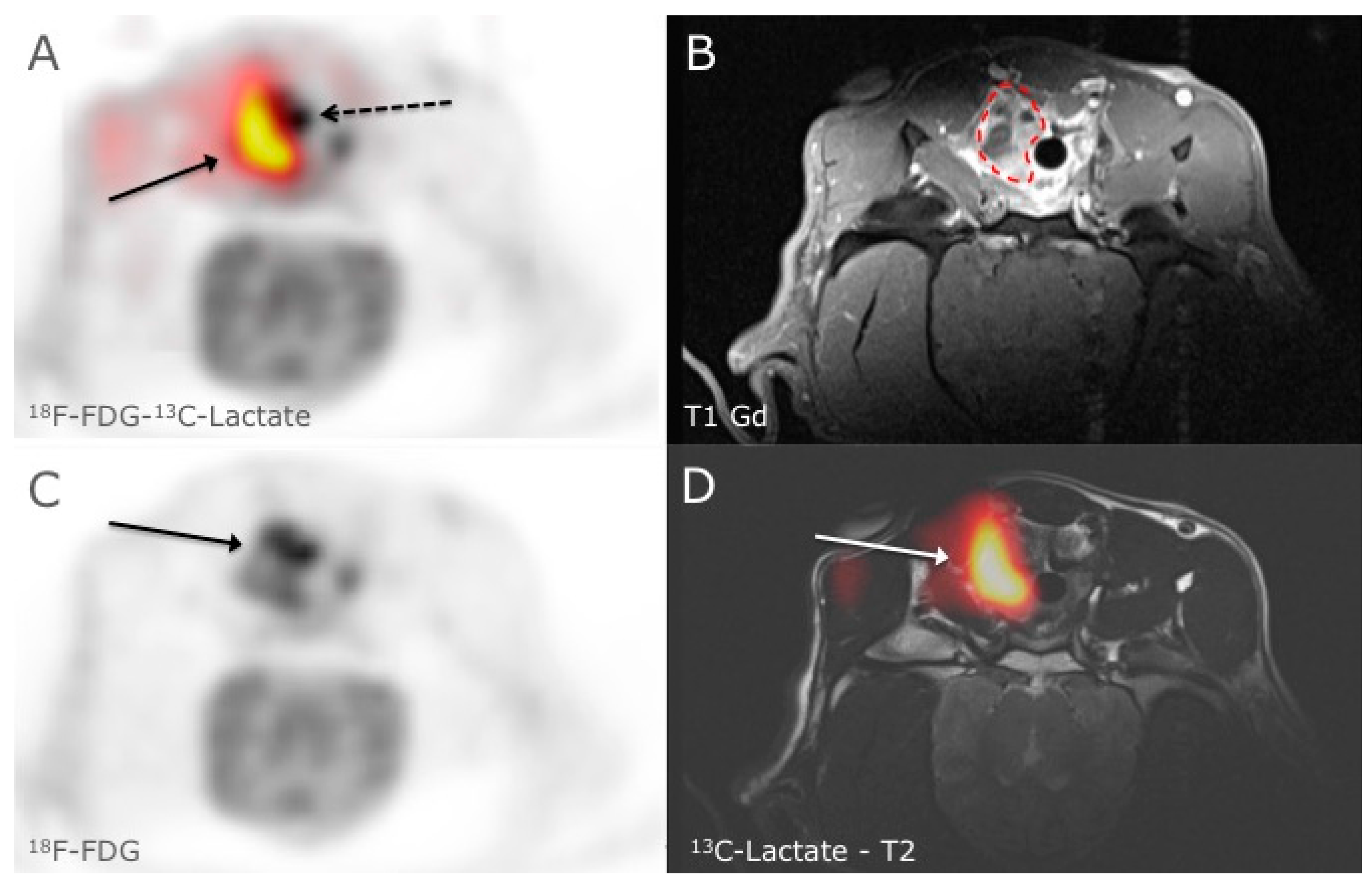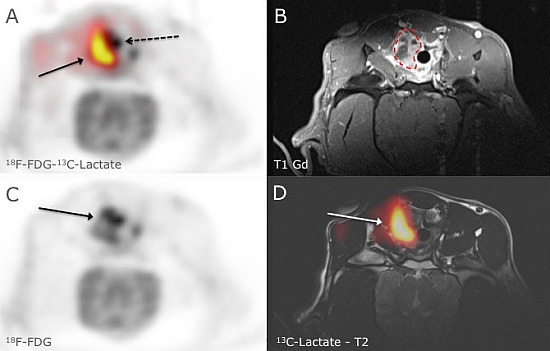In Vivo Phenotyping of Tumor Metabolism in a Canine Cancer Patient with Simultaneous 18F-FDG-PET and Hyperpolarized 13C-Pyruvate Magnetic Resonance Spectroscopic Imaging (hyperPET): Mismatch Demonstrates that FDG may not Always Reflect the Warburg Effect
Abstract
:
Acknowledgments
Author Contributions
Conflicts of Interest
References
- Gutte, H.; Hansen, A.E.; Henriksen, S.T.; Johannesen, H.H.; Ardenkjaer-Larsen, J.; Vignaud, A.; Hansen, A.E.; Børresen, B.; Klausen, T.L.; Wittekind, A.M.N.; et al. Simultaneous hyperpolarized 13C-pyruvate MRI and 18F-FDG-PET in cancer (hyperPET): Feasibility of a new imaging concept using a clinical PET/MRI scanner. Am. J. Nuclear Med. Mol. Imaging 2015, 5, 38–45. [Google Scholar]
- Johnbeck, C.B.; Jensen, M.M.; Nielsen, C.H.; Hag, A.M.F.; Knigge, U.; Kjær, A. 18F-FDG and 18F-FLT-PET Imaging for Monitoring Everolimus Effect on Tumor-Growth in Neuroendocrine Tumors: Studies in Human Tumor Xenografts in Mice. PLoS ONE 2014, 9, e91387. [Google Scholar] [CrossRef] [PubMed]
- Vander Heiden, M.G.; Cantley, L.C.; Thompson, C.B. Understanding the Warburg Effect: The Metabolic Requirements of Cell Proliferation. Science 2009, 324, 1029–1033. [Google Scholar] [CrossRef] [PubMed]
- Jensen, M.M.; Erichsen, K.D.; Johnbeck, C.B.; Björkling, F.; Madsen, J.; Jensen, P.B.; Sehested, M.; Højgaard, L.; Kjær, A. [18F]FDG and [18F]FLT positron emission tomography imaging following treatment with belinostat in human ovary cancer xenografts in mice. BMC Cancer 2013, 13, 168. [Google Scholar] [CrossRef] [PubMed]
© 2015 by the authors; licensee MDPI, Basel, Switzerland. This article is an open access article distributed under the terms and conditions of the Creative Commons Attribution license (http://creativecommons.org/licenses/by/4.0/).
Share and Cite
Gutte, H.; Hansen, A.E.; Larsen, M.M.E.; Rahbek, S.; Johannesen, H.H.; Ardenkjaer-Larsen, J.; Kristensen, A.T.; Højgaard, L.; Kjaer, A. In Vivo Phenotyping of Tumor Metabolism in a Canine Cancer Patient with Simultaneous 18F-FDG-PET and Hyperpolarized 13C-Pyruvate Magnetic Resonance Spectroscopic Imaging (hyperPET): Mismatch Demonstrates that FDG may not Always Reflect the Warburg Effect. Diagnostics 2015, 5, 287-289. https://doi.org/10.3390/diagnostics5030287
Gutte H, Hansen AE, Larsen MME, Rahbek S, Johannesen HH, Ardenkjaer-Larsen J, Kristensen AT, Højgaard L, Kjaer A. In Vivo Phenotyping of Tumor Metabolism in a Canine Cancer Patient with Simultaneous 18F-FDG-PET and Hyperpolarized 13C-Pyruvate Magnetic Resonance Spectroscopic Imaging (hyperPET): Mismatch Demonstrates that FDG may not Always Reflect the Warburg Effect. Diagnostics. 2015; 5(3):287-289. https://doi.org/10.3390/diagnostics5030287
Chicago/Turabian StyleGutte, Henrik, Adam E. Hansen, Majbrit M.E. Larsen, Sofie Rahbek, Helle H. Johannesen, Jan Ardenkjaer-Larsen, Annemarie T. Kristensen, Liselotte Højgaard, and Andreas Kjaer. 2015. "In Vivo Phenotyping of Tumor Metabolism in a Canine Cancer Patient with Simultaneous 18F-FDG-PET and Hyperpolarized 13C-Pyruvate Magnetic Resonance Spectroscopic Imaging (hyperPET): Mismatch Demonstrates that FDG may not Always Reflect the Warburg Effect" Diagnostics 5, no. 3: 287-289. https://doi.org/10.3390/diagnostics5030287
APA StyleGutte, H., Hansen, A. E., Larsen, M. M. E., Rahbek, S., Johannesen, H. H., Ardenkjaer-Larsen, J., Kristensen, A. T., Højgaard, L., & Kjaer, A. (2015). In Vivo Phenotyping of Tumor Metabolism in a Canine Cancer Patient with Simultaneous 18F-FDG-PET and Hyperpolarized 13C-Pyruvate Magnetic Resonance Spectroscopic Imaging (hyperPET): Mismatch Demonstrates that FDG may not Always Reflect the Warburg Effect. Diagnostics, 5(3), 287-289. https://doi.org/10.3390/diagnostics5030287







